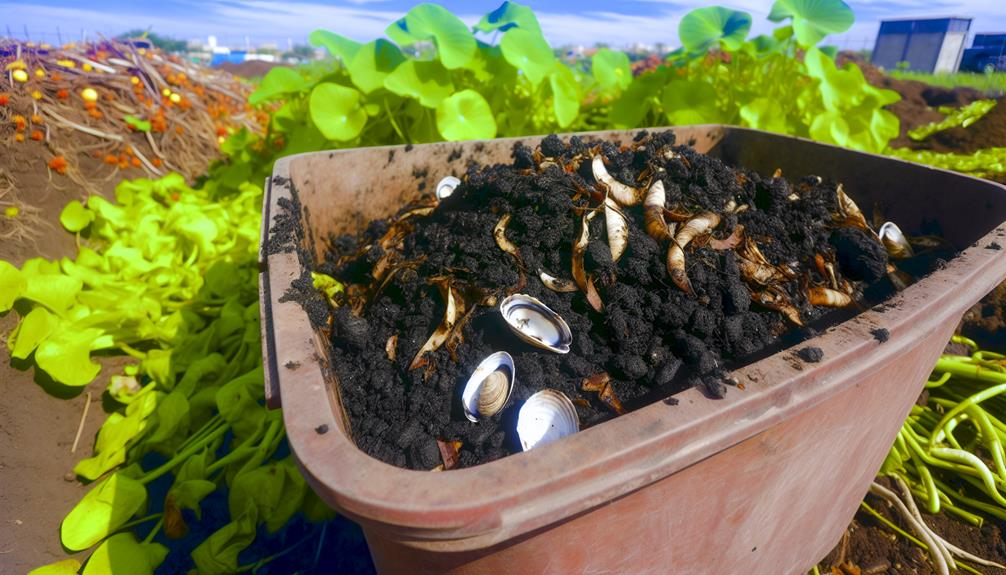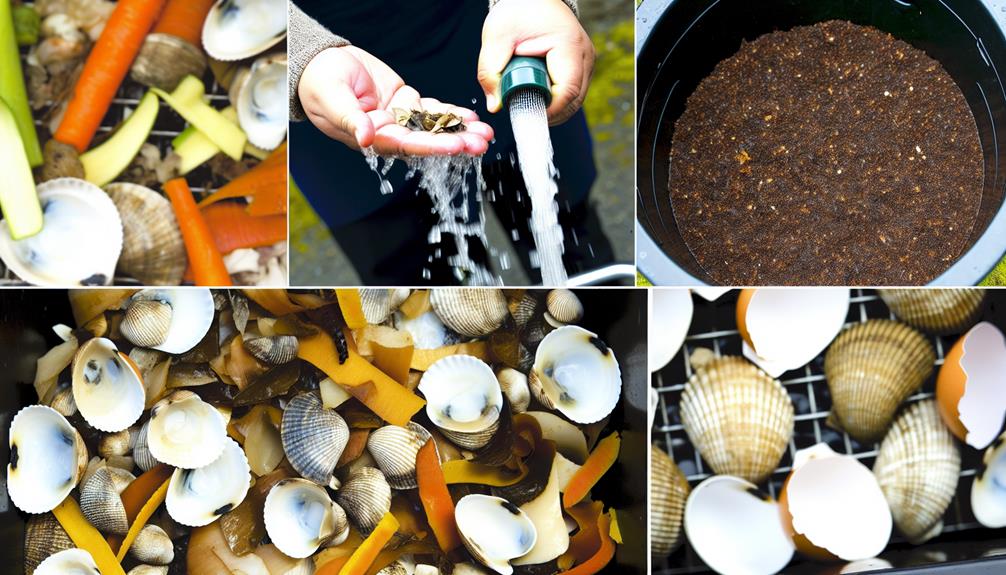

Composting is an eco-friendly practice that transforms kitchen waste into nutrient-rich soil. Among the various materials you can compost, clam shells stand out for their unique benefits. These shells, primarily composed of calcium carbonate, not only enrich your compost but also improve soil structure.
However, they require proper preparation, such as boiling and crushing, to break down efficiently. Imagine turning what could be waste into a valuable resource that supports sustainable gardening practices while enhancing your garden’s health. The journey to effective composting with clam shells is both rewarding and impactful.
Clam shells are primarily composed of calcium carbonate, making them a valuable addition to your compost pile. By understanding the composition of clam shells, you can make informed decisions about their use in composting, ensuring you’re contributing to both your garden’s health and sustainable practices.
In marine biology, calcium carbonate plays an important role in forming the hard shells of various marine organisms, including clams. This compound helps maintain the structural integrity and protection of these creatures. When you engage in shell recycling, you’re basically repurposing this natural resource, minimizing waste, and enhancing your soil’s nutrient profile.
To get started, make sure you thoroughly clean the clam shells to remove any residual organic material. This prevents unwanted odors and pests. You can crush the shells into smaller pieces to speed up their decomposition process. Smaller fragments break down more easily, allowing the calcium carbonate to be released into the soil more efficiently.
Composting is an innovative and sustainable practice that transforms organic waste into nutrient-rich soil amendments. While many gardeners are familiar with composting kitchen scraps and yard waste, clam shells offer a unique and valuable addition to the composting process. These calcium-rich marine remnants can provide surprising benefits to your compost and garden ecosystem, turning what might otherwise be discarded into a resourceful nutrient source.
pH Balancing Properties – Clam shells are primarily composed of calcium carbonate, which helps neutralize acidic compost environments. By introducing crushed shells, you can effectively balance the pH levels in your compost, creating a more optimal setting for decomposition and nutrient availability.
Calcium Nutrient Enrichment – Incorporating crushed clam shells provides an essential nutrient source for plant growth. Calcium plays a crucial role in cell wall formation, root development, and overall plant strength. As the shells slowly decompose, they continuously release calcium into the compost, enhancing soil fertility.
Waste Reduction and Sustainability – By composting clam shells, you’re participating in a sustainable waste management practice. Instead of discarding these shells, you’re recycling them into a valuable resource that can nourish your garden and reduce landfill waste.
Long-Term Soil Improvement – While clam shells decompose slowly—potentially taking six months to two years—they offer long-term benefits. As they break down, they gradually release nutrients and improve soil structure, creating a rich and nourishing environment for plant growth.
Also Read: Can You Compost Bag?
Before incorporating clam shells into your compost, it’s important to clean them thoroughly to remove any residual meat or debris. This step guarantees you’re not attracting pests or introducing unwanted smells to your compost pile.

Here’s how you can prepare your clam shells efficiently:
Incorporate the crushed clam shells into your compost pile by evenly distributing them throughout the layers. This guarantees they mix well with other organic materials, promoting even decomposition. Clam shells are a great addition because they add calcium, improving soil structure and helping plants thrive. Crushing the shells speeds up their breakdown, making nutrients more readily available.
By adding clam shells, you contribute to seafood sustainability and practice shell recycling. This reduces waste and gives a second life to materials that would otherwise be discarded. Not only are you enriching your compost, but you’re also making an environmentally friendly choice.
To start, lay down a layer of green waste, such as vegetable scraps or grass clippings. Then, sprinkle a thin layer of crushed clam shells over it. Follow with brown waste, like dried leaves or cardboard. Repeat this layering process, ensuring the shells are well-integrated each time.
To create a balanced compost mix, you need to understand the difference between green and brown materials. Guarantee you’re maintaining the right moisture and aeration levels.
Pay attention to the carbon-nitrogen ratio to keep your compost healthy and efficient.
Balancing your compost mix hinges on understanding the essential difference between green materials, rich in nitrogen, and brown materials, abundant in carbon. Green materials include items like fruit scraps, vegetable peels, coffee grounds, and fresh grass clippings. They decompose quickly and provide necessary nitrogen, important for microbial growth and activity.
On the other hand, brown materials are things like dried leaves, straw, cardboard, and wood chips. These items break down more slowly but supply the carbon necessary to feed the microorganisms that break down your compost pile. Ensuring a balanced mix of these materials creates an efficient composting process.
To make your compost mix effective, follow these steps:
Maintaining the right moisture and aeration levels in your compost pile is essential for efficient decomposition. You want to create an environment where microorganisms can thrive. Too much moisture can drown these beneficial organisms, while too little can slow down the composting process. Aim for your compost to feel like a wrung-out sponge—moist but not soggy.
Aeration techniques are equally important. Regularly turning your compost pile helps introduce oxygen, which speeds up decomposition. You can use a pitchfork or a compost aerator tool to mix the materials.
To help you monitor and balance moisture retention and aeration, here’s a simple guide:
| Condition | Signs | Solution |
|---|---|---|
| Too Wet | Foul odor, slimy texture | Add dry materials like straw or paper |
| Too Dry | Slow decomposition, crumbly texture | Add water, mix in moist greens |
| Poor Aeration | Compact, matted materials, unpleasant smell | Turn pile more frequently, add coarse items |
Achieving the correct carbon-nitrogen ratio is essential for creating nutrient-rich compost that breaks down efficiently. To balance your compost mix, aim for a ratio of about 30:1 carbon to nitrogen. This balance helps optimize decomposition speed and reduces the climate impact of your composting efforts.
Here’s how you can manage it:
Also Read: Can You Compost Cedar Chips?
Clam shells can take several months to multiple years to decompose, depending on environmental conditions and how finely they’re crushed. The environmental impact of decomposing clam shells is relatively minimal, but understanding the decomposition timeline can help you manage your compost more effectively.
First, consider the conditions of your compost. A well-maintained compost pile with proper aeration, moisture, and temperature will accelerate the breakdown process. Crushing the shells into smaller pieces also speeds up decomposition, making nutrients more readily available for your garden.
You might be wondering why clam shells take so long to break down. Their tough, calcium-rich structure is designed to protect the clam, making it resistant to decay. In nature, it can take years for shells to fully decompose, but in a managed compost system, you can reduce this time significantly.
To be part of a community that values sustainability, you should regularly check and maintain your compost. Turn the pile frequently, make sure it’s moist but not waterlogged, and crush the shells as finely as possible. This attention to detail will help you create rich, nutritious compost while minimizing waste and promoting environmental stewardship.
Clamshell use containers represent a remarkable packaging solution that has revolutionized multiple industries through their versatile and practical design. These hinged, shell-like containers offer exceptional functionality across various sectors, providing efficient storage, transportation, and presentation methods for diverse products and materials.
Food Service and Packaging – In the food service and packaging industry, clamshell containers are extensively used for takeout meals, restaurant packaging, bakery and deli products, fresh produce storage, prepared salads, sandwiches, and portion-controlled food items. Their design ensures food safety, maintains product freshness, and provides convenient handling for both businesses and consumers.
Construction and Material Handling – Construction and material handling sectors leverage clamshell containers for critical functions such as excavation, soil movement, bulk material transportation, debris removal, and heavy-duty material handling. These containers can be easily attached to cranes and excavators, making them essential tools for efficient project management and site operations.
Retail and Product Packaging – Retail and product packaging benefit significantly from clamshell designs, which are used for electronics packaging, hardware and tool storage, small component packaging, protective product displays, and tamper-resistant product presentations. Their transparent and secure nature allows customers to view products while ensuring their protection.
Agricultural and Horticultural Applications – Agricultural and horticultural industries utilize clamshell containers for seedling transportation, plant nursery packaging, fresh produce storage, fruit and vegetable packaging, and seed and fertilizer distribution. These containers provide optimal protection, ventilation, and organization for delicate agricultural products, supporting efficient farming and gardening practices.
With these versatile options, you can repurpose clam shells in creative and practical ways, enriching both your home and garden environment.
Also Read: Can You Compost Bread Crumbs?
Gardeners and agricultural enthusiasts are constantly seeking natural, environmentally friendly methods to protect their plants from destructive pests. Crushed seashells offer an innovative and organic solution for pest management, leveraging the unique physical properties of these marine remnants to create a hostile environment for unwanted garden visitors.
Crushed seashells function as a natural pest deterrent through several mechanisms:
The natural, non-toxic approach of using crushed seashells makes them an attractive alternative to chemical pesticides for environmentally conscious gardeners.
Yes, clam shells can attract pests to your compost pile. For effective pest control, crush and bury them deep in the pile. These composting tips will help you maintain a healthy, pest-free community compost.
When you compost clam shells, you’re addressing marine pollution by recycling natural waste. However, consider shell longevity—they take years to break down. If you’re eco-conscious, incorporate them mindfully to minimize environmental impact and feel good about your efforts.
Mussel shells are compostable and can be added to green waste recycling bins. They can also be crushed and used in garden composting, providing beneficial minerals to soil.
You can compost clam shells in a worm bin, but it’ll take time for worm digestion. Including clam shells can enhance vermicompost benefits by adding valuable minerals, fostering a nutrient-rich environment for your garden community.
Yes, lobster shells can be composted. They provide valuable nutrients like calcium, magnesium, and nitrogen, and help improve soil health when properly prepared by rinsing and crushing before adding to the compost pile.
Composting clam shells is a sustainable practice that contributes positively to both waste reduction and soil health. Proper preparation, such as boiling and crushing the shells, ensures they break down efficiently and release essential nutrients like calcium into the compost.
While clam shells are indeed compostable, their decomposition can take months to years, depending on conditions. By incorporating them into your compost pile, you not only enrich the soil but also support eco-friendly practices, making a significant impact on reducing kitchen waste and promoting sustainability.
